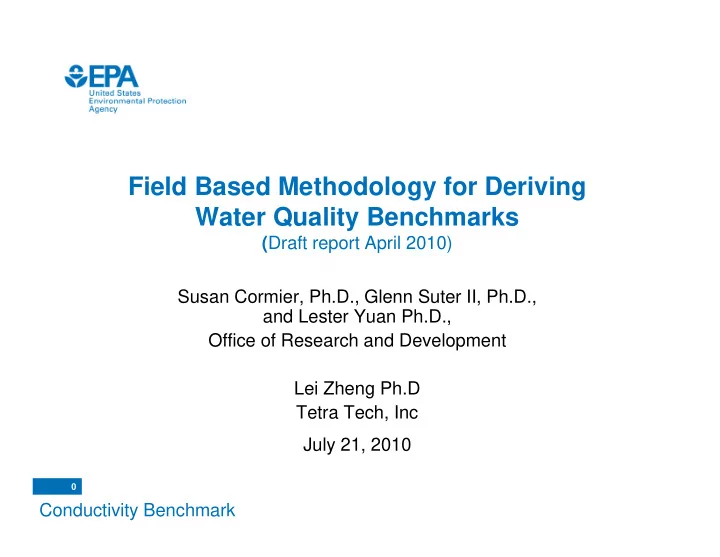

Field Based Methodology for Deriving Water Quality Benchmarks ( Draft report April 2010) Susan Cormier, Ph.D., Glenn Suter II, Ph.D., and Lester Yuan Ph.D., Office of Research and Development Lei Zheng Ph.D Tetra Tech, Inc July 21, 2010 0 Conductivity Benchmark
Development of benchmark based on three key decisions Followed EPA’s methodology for developing 1. Water Quality Criteria that has been used for 25 years Used field data rather than laboratory toxicity 2. test results Selected an effect that is clearly adverse: the 3. extirpation of genera. 1 Conductivity Benchmark
Approach for Deriving Conductivity Advisory Level Long standing U.S. EPA procedure for developing water quality criteria • Lab-based Toxicity Testing – standard method for deriving Water Quality Criteria – end-points well-established (LC 50 and chronic value) – confounding variables more easily controlled – fewer species tested; species may not occur in field – conditions differ from field Adapted procedure to use field data from Central Appalachia streams • Field Data – uses native species acclimated to local conditions – many more species evaluated – conditions realistic and relevant – must account for confounding variables 2 Conductivity Benchmark
Each genus extirpation value arranged from least to most Field Derived sensitive SSD 5th percentile Benchmark Level 3 Conductivity Benchmark
Process for Developing Field Based Benchmark 1. Estimate XC 95 s for each genus (level above which a genus is rarely observed). 2. Develop a distribution of the XC 95 s. 3. Find the conductivity level corresponding to the 5 th percentile. 4 Conductivity Benchmark
Process for Developing Field Based Benchmark G G G G G G G_ GG _ _ G _ _ _ _ _ _ _ _ Increasing conductivity Rank all observations of a genus with respect to conductivity. Adjust for unequal sampling effort along the conductivity gradient by weighting observations. 5 Conductivity Benchmark
Process for Developing Field Based Benchmark G G G G G G G_ G G _ _ G _ _ _ _ _ _ _ _ XC 95 for this genus Increasing conductivity Estimate the XC 95 , the conductivity level above which a genus is effectively gone from the system (the 95th percentile of occurrences of the genus). Repeat for all genera occurring in >30 sites and at least once in a reference site. 6 Conductivity Benchmark
Process for Developing Field Based Benchmark XC 95 XC 95 XC 95 XC 95 XC 95 XC 95 XC 95 XC 95 XC 95 XC 95 XC 95 XC 95 XC 95 XC 95 XC 95 XC 95 XC 95 XC 95 XC 95 XC 95 HC 05 Increasing conductivity Develop the sensitivity distribution by rank ordering the XC 95 values with respect to conductivity for all genera. HC 05 = the conductivity corresponding to the 5th percentile on the sensitivity distribution; intended to protect 95% of species. 7 Conductivity Benchmark
Used West Virginia Data Set Trimmed to Reduce Influence of Other Variables Removed sites • With pH <6 – reflects acid mine drainage – Water Quality Criterion already available, pH >6.5 • With conductivities >1000 µs/cm, chloride >250 and sulfate <125 mg/L –Different ionic mixtures have different biological effects • From large rivers –sampling protocols were different Other variables considered • Habitat quality, organic enrichment, temperature, nutrients, pH >8.5, deposited sediment, lack of headwaters, stream size, Se • Effect on results minimal. No action taken 8 Conductivity Benchmark
Process for Developing Field Based Benchmark Step 1 details. Adjust for unequal sampling effort along the conductivity gradient by weighting observations. Divide the observation of a genus by the number of observations within a conductivity bin. 9 Conductivity Benchmark
Representative Distributions of Occurrence 10 Conductivity Benchmark
Process for Developing Field Based Benchmark Step 2 details . Estimate the conductivity level above which each genus is effectively gone from the system as the 95 th percentile of occurrences of the genus. This level is called the extirpation concentration (XC 95 ). 11 Conductivity Benchmark
Sensitivity Distribution of Invertebrate Genera 151 genera represented 0.05 HC 05 297 Conductivity µS/cm 12 Conductivity Benchmark
Hazardous Concentration Point 95% Confidence HC Level Estimate Interval (% species loss) (µS/cm) (µS/cm) HC 05 297 225-305 13 Conductivity Benchmark
Comparison of WV and KY Data West Virginia HC 05 Kentucky HC 05 297 µS/cm 319 µS/cm March − October February − October (225-305) (180-439) Legend Ecoregion 69 and 70 Advisory Area States 69 70 69 350 175 0 350 Kilometers 14 Conductivity Benchmark
Removal of Potential Confounders 0.5 0.4 Proportion of genera 0.3 0.2 0.1 0.0 100 200 500 1000 2000 15 Conductivity (µS/cm)
Summary of Causal Evidence Characteristic Evidence Score Co - occurrence Loss of genera occurs where conductivity is high even + + + when potential confounding causes are low but is rare when conductivity is low. Preceding Sources of conductivity are present and are shown to + + + Causation increase stream conductivity in the region Interaction Aquatic organisms are directly exposed to dissolved salts. + Physiological studies document effects of ion imbalance. Alteration Characteristic genera and assemblages are affected at + + sites with higher conductivity. Sufficiency Increased exposure in both concentration and duration to + + + salt affects invertebrates based on both field and laboratory analyses. Time order Conductivity increases, and local extirpation occurs after NE mining permits are issued, but before and after data are 16 not available.
Recommended Conductivity Benchmark 300 micro Siemens per centimeter (µS/cm) • Uses field data rather than lab-based bioassays • Aims to protect 95% of invertebrate species living in Central Appalachian streams • Advisory value is calculated using WV stream data; validated with KY data • Limited to streams dominated by sulfate and bicarbonate ions at neutral to alkaline pH 17 Conductivity Benchmark
Recommend
More recommend